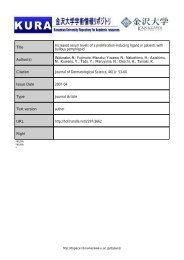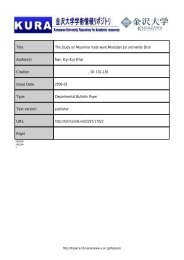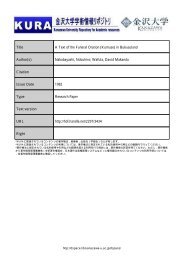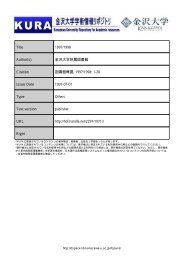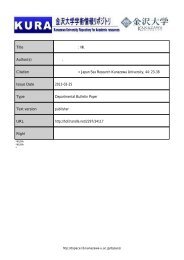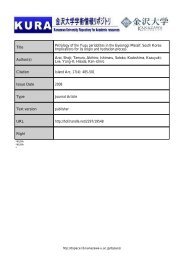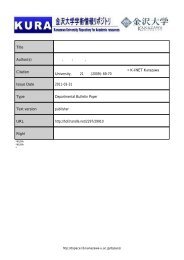Title Krafft temperature and enthalpy of solution of N-acyl amino acid ...
Title Krafft temperature and enthalpy of solution of N-acyl amino acid ...
Title Krafft temperature and enthalpy of solution of N-acyl amino acid ...
You also want an ePaper? Increase the reach of your titles
YUMPU automatically turns print PDFs into web optimized ePapers that Google loves.
Abstract<br />
The <strong>Krafft</strong> <strong>temperature</strong>s <strong>and</strong> the enthalpies <strong>of</strong> <strong>solution</strong> <strong>of</strong> six kinds <strong>of</strong><br />
N-hexadecanoyl <strong>amino</strong> <strong>acid</strong> surfactant (Gly, Ala, Val, Leu, Ile, <strong>and</strong> Phe)<br />
were obtained from both solubility measurements <strong>and</strong> differential scanning<br />
calorimetry. It was shown that the <strong>Krafft</strong> <strong>temperature</strong> <strong>of</strong> N-hexadecanoyl<br />
<strong>amino</strong> <strong>acid</strong> surfactant increased with decreasing size <strong>of</strong> the <strong>amino</strong> <strong>acid</strong><br />
residue except for the case <strong>of</strong> phenylalanine. On the other h<strong>and</strong>, the<br />
<strong>enthalpy</strong> <strong>of</strong> <strong>solution</strong> was endothermic <strong>and</strong> increased with decreasing size <strong>of</strong><br />
the <strong>amino</strong> <strong>acid</strong> residue except for the cases <strong>of</strong> glycine <strong>and</strong> phenylalanine.<br />
It was found from these results that the D-L interaction was superior to the<br />
L-L interaction in solid state <strong>of</strong> N-hexadecanoyl <strong>amino</strong> <strong>acid</strong> surfactant salt<br />
for both the alanine <strong>and</strong> phenylalanine systems. It was suggested by ab<br />
initio calculations that the difference <strong>of</strong> the magnitude <strong>of</strong> the<br />
peptide-peptide hydrogen bonding was dominant factor for the chiral<br />
effect.<br />
Keywords N-Acyl <strong>amino</strong> <strong>acid</strong> surfactant • <strong>Krafft</strong> <strong>temperature</strong> •<br />
Enthalpy <strong>of</strong> <strong>solution</strong> • Amino <strong>acid</strong> residue • Chiral effect<br />
Introduction<br />
N-Acyl <strong>amino</strong> <strong>acid</strong> surfactants, which are anionic <strong>amino</strong> <strong>acid</strong>-type<br />
surfactants, are <strong>of</strong> immense importance both from the industrial <strong>and</strong> the<br />
domestic viewpoints because <strong>of</strong> their biodegradability <strong>and</strong> low toxicity [1].<br />
Micelle formation is an important property <strong>of</strong> surfactants, <strong>and</strong> has been the<br />
subject <strong>of</strong> intense research [2-8]. The aggregation number <strong>of</strong> a micelle is<br />
same order as that for general anionic surfactants (ca. 40~100) <strong>and</strong><br />
2




